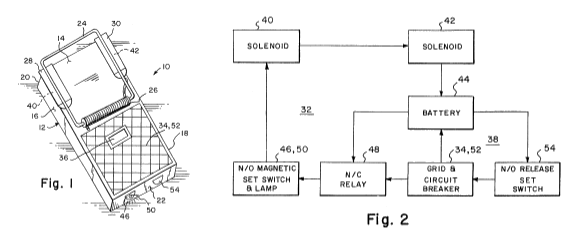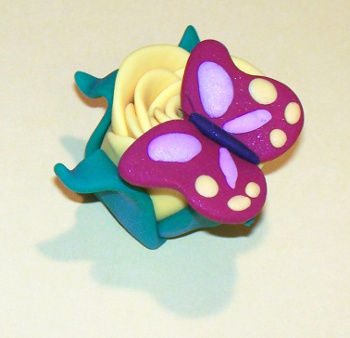Silly Putty
August 6, 2014
There's a saying, "
Build a better mousetrap, and the world will beat a path to your door." This saying is a mélange of two
19th century quotations by
Ralph Waldo Emerson. The phrase is popular, since it's a paean to
innovation.
Inventors have heeded the call, since a search of the
US Patent and Trademark Office yields 187
patents from 1790 to the present with "mouse trap" or "mousetrap" in their title. Ninety-two of these were granted from 1976 to the present.

Figures one and two from Donald W. Dufaux and George Spector, "Magnetic computerized mouse trap," US Patent No. 5,528,853, June 25, 1996. (Google Patents.)[1)]
Not all innovations are patent-worthy, since it's important to look at the
economics of practicing the invention. There's a considerable cost in prosecuting a patent application, the cost of
maintenance fees, and the possible cost of defending the patent against
infringers. In the mousetrap case, why would anyone want to buy your particularly effective mousetrap when they can buy a package of several conventional,
spring traps for a
dollar at many stores?
Some patented inventions make a lot of money.
Chester Carlson's invention of
xerography is one example.[2] I wrote about Carlson and his invention in a
previous article (PARC Turns Forty, September 28, 2010). A more recent example is
Pfizer's cholesterol-lowering
drug,
Lipitor. Lipitor's 1993 patent, which expired in 2011, resulted in more than $100 billion in
revenue for Pfizer. The Lipitor patent is considered to have been the most lucrative patent.[3]
Most companies don't rely on just a single patent to protect their product line. They're constantly patenting improvements, or possible alternatives to what they
manufacture. They sometimes
license these in a package to other companies, such
patent portfolios increasing the value of fundamental patents with added fortification against infringers.
About a
decade ago,
NTP, Inc. was able to extract a $612.5 million payment from Research in Motion (now,
BlackBerry Limited, manufacturer of the
BlackBerry) for infringing its patents on a
wireless email system. The settlement came only after protracted
litigation, which, as I mentioned earlier, is another cost center for patents.
As
scientists will admit, failures in the
laboratory sometimes turn into unexpected successes. This is often the case when a failed
industrial process becomes a
consumer product. One example of this was the early attempt by
American scientist,
Thomas Adams (1818-1905), to use
chicle, the
natural gum of
Manilkara trees, as a replacement for
rubber. Instead, he went on to invent
chewing gum.
Sculpey is a popular
polymer clay used for
sculpting by
Children and
artists. It has the desirable
property that it's soft, and easily worked, but it can be hardened in a low
temperature oven. The Sculpey
composition was originally intended as a
thermal transfer compound, since it could be
formulated to contain a high proportion of
thermally conducting fillers. A composition similar to Sculpey contains the following:[4]
Polyvinylchloride, 5 - 95 weight-%
Phthalate-free softener, 5 - 30 weight-%
Stabiliser, 0 - 10 weight-%
Co-stabiliser, 0 - 10 weight-%
Fillers, 0 - 75 weight-%
Colorant, 0 - 5 weight-%
Other additives, 0 - 5 weight-%

Sculpey sculpture, "Butterfly on a Flower," created by my daughter when she was an elementary school student.
(Photo by the author.)
Play-Doh is another popular children's modeling compound originally manufactured for another purpose; namely, a
wallpaper cleaner. The original formulation was
wheat flour,
water,
salt,
boric acid, and
mineral oil. A modern composition is as follows:[5]
Sodium chloride, 3% to ~10%
Calcium chloride, ~3% to ~10%
Aluminum sulfate, ~0.5% to ~1.1%
10 molar borax decahydrate, ~0.35% to ~0.80%
Sodium benzoate, ~0.1% to ~0.5%
Wheat flour,~30% to ~38%
Waxy corn starch, ~3.5% to ~7.0%
Polyethylene glycol (PEG 1500) monostearate, ~0.4% to ~1.0%
Mineral oil, ~2.5% to ~4.0%
Vanilla fragrance, ~0.05% to ~0.25%
Water, balance (~45%)
In this composition, the amounts of aluminum sulfate and borax decahydrate are adjusted to give a
pH in the range of about 3.5 to about 4.5. Now you know that the Play-Doh smell is vanilla. The composition can be
pigmented.
Silly Putty is another example of a failed rubber substitute becoming a popular consumer play item. The Silly Putty
trademark is owned by
Crayola, but there are similar materials sold under different names. That's because the original research goes back to
World War II, when the
US was looking for alternative rubber materials.
The original starting composition was just
polydimethylsiloxane, [C
2H
6OSi]
n, a
silicone oil, reacted with
boric acid.[6-7] The unusual
mechanical characteristic of this material is that it can be slowly worked, like a clay, but it behaves as an
elastic solid when the
rate of applied
force is large. This characteristic is a result of the
viscoelasticity of the polydimethylsiloxane.

The structure of polydimethylsiloxane.
(Via Wikimedia Commons.)
According to
Wikipedia, this is the composition of Silly Putty:
Dimethyl siloxane polymer, terminated with boric acid, 65%
Silica (crystalline quartz), 17%
Thixatrol ST (castor oil derivative), 9%
Polydimethylsiloxane, 4%
Decamethyl cyclopentasiloxane, 1%
Glycerine, 1%
Titanium dioxide, 1%
Over the years, inventors have developed improved compositions.[8] More than four thousand
tons of Silly Putty have been sold since 1950.[9] The package size is 0.46
ounce (13
grams); so, doing the
math, more than 278 million units have been sold.
References:
- Donald W. Dufaux and George Spector, "Magnetic computerized mouse trap," US Patent No. 5,528,853, June 25, 1996.
- Chester F. Carlson, "electrophotography," US Patent No. 2,297,691 (October 6, 1942).
-
Bruce D. Roth, "[R-(R*R*)]-2-(4-fluorophenyl)-β,δ-dihydroxy-5-(1-methylethyl-3-phenyl-4-[(phenylamino) carbonyl]- 1H-pyrrole-1-heptanoic acid, its lactone form and salts thereof," US Patent No. 5,273,995, December 28, 1993.
- Yvette Freese, Ingrid Reutter, and Heinrich Schnorrer, "Modeling composition and its use," European Patent No. EP1957572, October 26, 2011.
- Linwood E. Doane, Jr., and Lev Tsimberg, "Starch-based modeling compound," US Patent No. 6,713,624, March 30, 2004.
- Mcgregor Rob Roy and Warrick Earl Leathen, "Treating dimethyl silicone polymer with boric oxide," US Patent No. 2,431,878, December 2, 1947.
- James G E Wright, "Process for making puttylike elastic plastic, siloxane derivative composition containing zinc hydroxide," US Patent No. 2,541,851, Feb 13, 1951.
- Maurice A. Minuto, "Method of Making Bouncing Silicone Putty-Like Compositions," US Patent No. 4371493, February 1, 1983.
- Eugene S. Robinson, "How That Pinkish Goo Called Silly Putty Came Out Of Its Shell," NPR, July 17, 2014.
Permanent Link to this article
Linked Keywords: Build a better mousetrap, and the world will beat a path to your door; 19th century; quotation; Ralph Waldo Emerson; innovation; inventor; United States Patent and Trademark Office; patent; Google Patents; economics; maintenance fee; patent infringement; infringer; spring-loaded bar mousetrap; spring trap; dollar; Chester Carlson; xerography; Pfizer; cholesterol; pharmaceutical drug; atorvastatin; Lipitor; revenue; manufacturing; manufacture; license; patent portfolio; decade; NTP, Inc.; BlackBerry Limited; BlackBerry; wireless network; email system; lawsuit; litigation; scientist; laboratory; industrial process; consumer product; American; Thomas Adams (1818-1905); chicle; natural gum; Manilkara; natural rubber; chewing gum; Sculpey; polymer clay; sculpture; sculpting; child; children; artist; physical property; temperature; oven; composition; thermal conductivity; thermal transfer compound; formulation; formulate; filler; polyvinyl chloride; polyvinylchloride; phthalate; plasticizer; softener; stabiliser; colorant; additive; butterfly; flower; daughter; elementary school; student; Play-Doh; wallpaper; wheat flour; water; salt; boric acid; mineral oil; sodium chloride; calcium chloride; aluminum sulfate; molar concentration; borax decahydrate; sodium benzoate; corn starch; polyethylene glycol; glycerol monostearate; vanillin; vanilla fragrance; pH; pigment; Silly Putty; trademark; Crayola; World War II; United States; US; polydimethylsiloxane; silicone oil; boric acid; mechanical characteristic; elasticity; elastic; solid; impulse; rate; force; viscoelasticity; Wikimedia Commons; Wikipedia; dimethyl siloxane; polymer; silicon dioxide; silica; crystal; crystalline; quartz; castor oil; derivative; decamethyl cyclopentasiloxane; glycerol; glycerine; titanium dioxide; ton; ounce; gram; mathematics; math; Donald W. Dufaux and George Spector, "Magnetic computerized mouse trap," US Patent No. 5,528,853, June 25, 1996; Chester F. Carlson, "electrophotography," US Patent No. 2,297,691 (October 6, 1942); Bruce D. Roth, "[R-(R*R*)]-2-(4-fluorophenyl)-β,δ-dihydroxy-5-(1-methylethyl-3-phenyl-4-[(phenylamino) carbonyl]- 1H-pyrrole-1-heptanoic acid, its lactone form and salts thereof," US Patent No. 5,273,995, December 28, 1993; Yvette Freese, Ingrid Reutter, and Heinrich Schnorrer, "Modeling composition and its use," European Patent No. EP1957572, October 26, 2011; Linwood E. Doane, Jr., and Lev Tsimberg, "Starch-based modeling compound," US Patent No. 6,713,624, March 30, 2004; Mcgregor Rob Roy and Warrick Earl Leathen, "Treating dimethyl silicone polymer with boric oxide," US Patent No. 2,431,878, December 2, 1947; James G E Wright, "Process for making puttylike elastic plastic, siloxane derivative composition containing zinc hydroxide," US Patent No. 2,541,851, Feb 13, 1951; Maurice A. Minuto, "Method of Making Bouncing Silicone Putty-Like Compositions," US Patent No. 4371493, February 1, 1983.